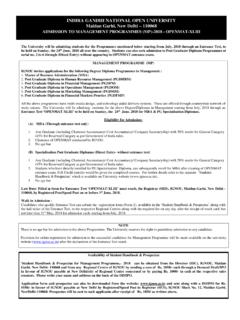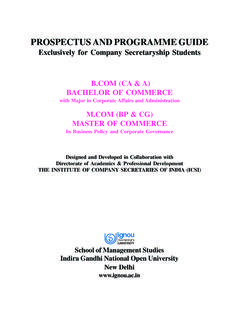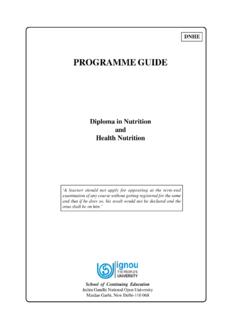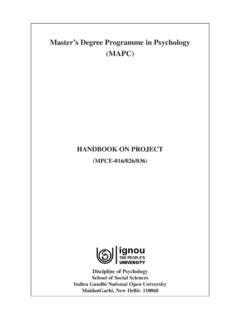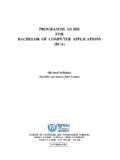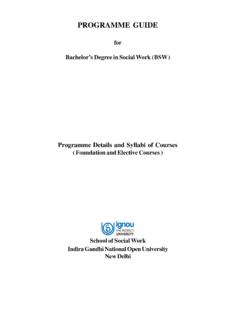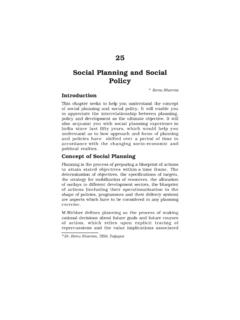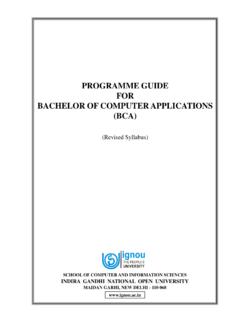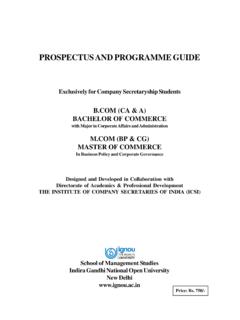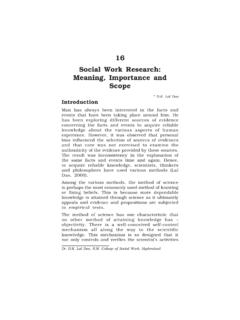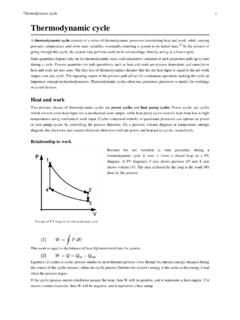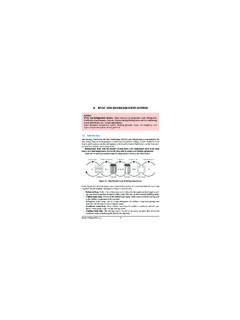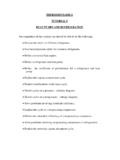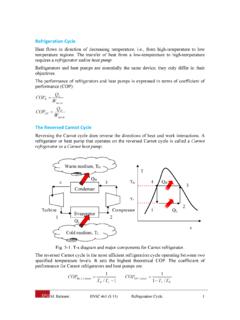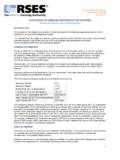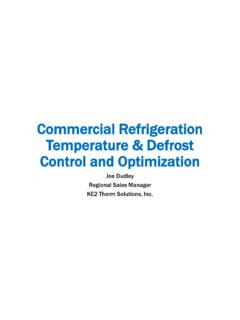Transcription of UNIT 2 REFRIGERATION CYCLE Refrigeration Cycle
1 17 REFRIGERATION CYCLE UNIT 2 REFRIGERATION CYCLE Structure Introduction Objectives Vapour Compression CYCLE Simple Vapour Compression REFRIGERATION CYCLE Theoretical Vapour Compression CYCLE with Saturated Vapour after Compression Conditions for Highest COP Carnot REFRIGERATION CYCLE Temperature Limitations Difference between REFRIGERATION and Heat Pump Cycles Vapour Absorption System Illustrative Problems Summary Answers to SAQs INTRODUCTION The term REFRIGERATION may be defined as the process of removing heat from a substance under controlled conditions. It also includes the process of reducing and maintaining the temperature of a body below the general temperature of its surroundings. In other words, the REFRIGERATION means a continued extraction of heat from a body whose temperature is already below temperature of its surroundings.
2 In a refrigerator, heat is virtually pumped from a lower temperature to a higher temperature. According to Second Law of Thermodynamics, this process can only be performed with the aid of some external work. It is thus obvious that supply of power is regularly required to drive a refrigerator. Theoretically, a refrigerator is a reversed heat engine or a heat pump which pumps heat from a cold body and delivers it to a hot body. The substance which works in a pump to extract heat from a cold body and to deliver it to a hot body is known as refrigerant. Objectives After studying this unit, you should be able to know what is REFRIGERATION CYCLE , understand about the vapour compression CYCLE , describe the vapour compression REFRIGERATION CYCLE , and solve the problem on REFRIGERATION system.
3 REFRIGERATION CYCLE is the basis of all REFRIGERATION systems. So REFRIGERATION CYCLE should be known to understand the REFRIGERATION system. Some basic REFRIGERATION cycles are discussed here through different diagrams. VAPOUR COMPRESSION CYCLE Vapour compression CYCLE is an improved type of air REFRIGERATION CYCLE in which a suitable working substance, termed as refrigerant, is used. The refrigerants generally used for this purpose are ammonia (NH3), carbon dioxide (CO2) and sulphur-dioxide (SO2). The refrigerant used, does not leave the system, but is circulated throughout the system alternately condensing and evaporating. In evaporating, the refrigerant absorbs its latent heat from the solution which is used for circulating it around the cold chamber and in condensing; it gives out its latent heat to the circulating water of the cooler.
4 18 REFRIGERATION and Air Conditioning The vapour compression CYCLE which is used in vapour compression REFRIGERATION system is now-a-days used for all purpose REFRIGERATION . It is used for all industrial purposes from a small domestic refrigerator to a big air conditioning plant. Simple Vapour Compression REFRIGERATION System It consists of the following essential parts: Compressor The low pressure and temperature vapour refrigerant from evaporator is drawn into the compressor through the inlet or suction valve A, where it is compressed to a high pressure and temperature. This high pressure and temperature vapour refrigerant is discharged into the condenser through the delivery or discharge valve B. Condenser The condenser or cooler consists of coils of pipe in which the high pressure and temperature vapour refrigerant is cooled and condensed.
5 Figure : Simple Vapour Compression REFRIGERATION System The refrigerant, while passing through the condenser, gives up its latent heat to the surrounding condensing medium which is normally air or water. Receiver The condensed liquid refrigerant from the condenser is stored in a vessel known as receiver from where it is supplied to the evaporator through the expansion valve or refrigerant control valve. Expansion Valve It is also called throttle valve or refrigerant control valve. The function of the expansion valve is to allow the liquid refrigerant under high pressure and temperature to pass at a controlled rate after reducing its pressure and temperature. Some of the liquid refrigerant evaporates as it passes through the expansion valve, but the greater portion is vaporized in the evaporator at the low pressure and temperature Evaporator An evaporator consists of coils of pipe in which the liquid-vapour.
6 Refrigerant at low pressure and temperature is evaporated and changed into vapour refrigerant at low pressure and temperature. In evaporating, the liquid vapour refrigerant absorbs its latent heat of vaporization from the medium (air, water or brine) which is to be cooled. 19 REFRIGERATION CYCLE Theoretical Vapour Compression CYCLE with Dry Saturated Vapour after Compression A vapour compression CYCLE with dry saturated vapour after compression is shown on T-s diagrams in Figures (a) and (b) respectively. At point 1, let T1, p1 and s1 be the temperature, pressure and entropy of the vapour refrigerant respectively. The four processes of the CYCLE are as follows : (a) T-s Diagram (b) p-h Diagram Figure : Theoretical vapour Compression CYCLE with Dry Saturated Vapour after Compression Compression Process The vapour refrigerant at low pressure p1 and temperatureT1 is compressed isentropically to dry saturated vapour as shown by the vertical line 1-2 on the T-s diagram and by the curve 1-2 on p-h diagram.
7 The pressure and temperature rise from p1 to p2 and T1 to T2 respectively. The work done during isentropic compression per kg of refrigerant is given by w = h2 h1 where h1 = Enthalpy of vapour refrigerant at temperature T1, at suction of the compressor, and h2 = Enthalpy of the vapour refrigerant at temperature T2. at discharge of the compressor. Condensing Process The high pressure and temperature vapour refrigerant from the compressor is passed through the condenser where it is completely condensed at constant pressure p2 and temperature T2 as shown by the horizontal line 2-3 on T-s and p-h diagrams. The vapour refrigerant is changed into liquid refrigerant. The refrigerant, while passing through the condenser, gives its latent heat to the surrounding condensing medium.
8 Expansion Process The liquid refrigerant at pressure p3 = p2 and temperature T3 = T2, is expanded by throttling process through the expansion valve to a low pressure p4 = p1 and Temperature T4 = T1 as shown by the curve 3-4 on T-s diagram and by the vertical line 3-4 on p-h diagram. Some of the liquid refrigerant evaporates as it passes through the expansion valve, but the greater portion is vaporized in the evaporator. We know that during the throttling process, no heat is absorbed or rejected by the liquid refrigerant. Vaporizing Process The liquid-vapour mixture of the refrigerant at pressure p4 = p1 and temperature T4 = T1 is evaporated and changed into vapour refrigerant at constant pressure and temperature, as shown by the horizontal line 4-1 on T-s and p-h diagrams. During evaporation, the liquid-vapour refrigerant absorbs its latent heat of vaporization 20 REFRIGERATION and Air Conditioning from the medium (air, water or brine) which, is to be cooled, This heat which is absorbed by the refrigerant is called refrigerating effect and it is briefly written as RE.
9 The process of vaporization continues up to point 1 which is the starting point and thus the CYCLE is completed. We know that the refrigerating effect or the heat absorbed or extracted by the liquid-vapour refrigerant during evaporation per kg of refrigerant is given by RE = h1 h4 = h1 hf3 where hf3 = Sensible heat at temperature T3, enthalpy of liquid refrigerant leaving the condenser. It may be noticed from the CYCLE that the liquid-vapour refrigerant has extracted heat during evaporation and the work will be done by the compressor for isentropic compression of the high pressure and temperature vapour refrigerant. Coefficient of performance, = (Refrigerating effect)/( Work done) =1421hhhh = 1321fhhhh Effect of Suction Pressure The suction pressure (or evaporator pressure) decreases due to the frictional resistance of flow of the refrigerant.
10 Let us consider a theoretical vapour compression CYCLE 1-2-3-4 when the suction pressure decreases from ps to ps as shown on p-h diagram in Figure It may be noted that the decrease in suction pressure : (a) decreases the refrigerating effect from (h1 h4) to (1411hh ), and (b) Increases the work required for compression from (h2 h1) to (1121hh ). Figure : Effect of Suction Pressure Since the , of the system is the ratio of refrigerating effect to the work done, therefore with the decrease in suction pressure, the net effect is to decrease the of the refrigerating system for the same refrigerant flow. Hence with the decrease in suction pressure the refrigerating capacity of the system decreases and the REFRIGERATION cost increases. Effect of Discharge Pressure In actual practice, the discharge pressure (or condenser pressure) increases due to frictional resistance of flow of the refrigerant.
